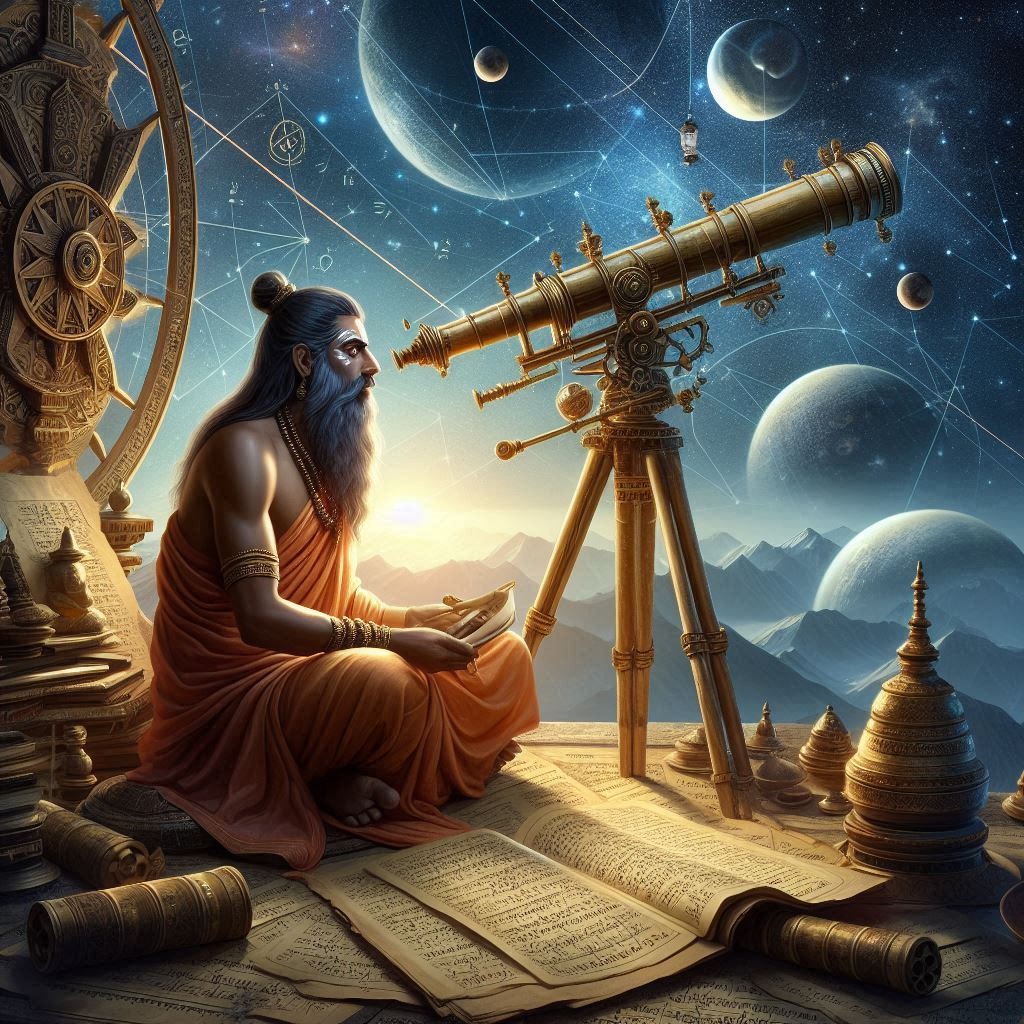Bhaskaracharya, also known as Bhaskara II, was an extraordinary mathematician and astronomer of ancient India. Born in the 12th century, his contributions to mathematics and astronomy have left a lasting legacy. This blog delves into his life, works, and the remarkable achievements that make him a pivotal figure in the history of science.
Early Life and Background Bhaskaracharya
Bhaskaracharya was born in 1114 CE in the region of Bijapur, Karnataka, India, which was then part of the flourishing kingdom of the Chalukyas. The Chalukya dynasty was known for its patronage of the arts and sciences, providing a rich cultural and intellectual environment. Bhaskara came from a lineage of scholars and astronomers. His father, Mahesvara, was a respected mathematician and astronomer, which undoubtedly provided Bhaskara with a solid foundation in these disciplines from a young age.
Growing up in such a scholarly environment, Bhaskara was exposed to various scientific texts and traditions. His early education likely included the study of classical Sanskrit texts and the works of earlier Indian mathematicians and astronomers, such as Aryabhata and Brahmagupta. This background set the stage for Bhaskara’s own contributions, as he built upon and expanded the knowledge passed down through generations.
Major Works and Contributions Bhaskaracharya
Bhaskaracharya’s most significant work, “Siddhanta Shiromani” (Crown of Treatises), is a testament to his genius. Written in 1150 CE, this comprehensive treatise is divided into four parts: Lilavati (arithmetic), Bijaganita (algebra), Grahaganita (mathematics of the planets), and Goladhyaya (spherical astronomy). Each section covers a wide range of mathematical and astronomical topics, demonstrating Bhaskara’s mastery and innovation in these fields.
Lilavati is named after Bhaskara’s daughter and is a poetic and engaging introduction to arithmetic and geometry. It includes numerous problems and solutions presented in verse form, making it accessible and enjoyable for students. The problems cover a variety of topics, from simple arithmetic operations to more complex geometric constructions.
Bijaganita is a pioneering work in algebra. It introduces concepts such as positive and negative numbers, and provides methods for solving quadratic, cubic, and quartic equations. Bhaskara’s treatment of these topics is thorough and systematic, reflecting his deep understanding of algebraic principles.
Grahaganita and Goladhyaya are dedicated to astronomy. Grahaganita deals with the mathematics of planetary motions, eclipses, and other celestial phenomena, while Goladhyaya focuses on the spherical geometry of the Earth and the heavens. These works demonstrate Bhaskara’s comprehensive understanding of both mathematical and observational astronomy.
Calculation of Earth's Rotation
One of Bhaskaracharya’s most remarkable achievements was his precise calculation of the time it takes for the Earth to complete one rotation on its axis. In “Siddhanta Shiromani,” he provided detailed calculations for various astronomical phenomena, including the duration of the Earth’s rotation. Although the specific figure of 23 hours, 56 minutes, and 4.1 seconds might not be explicitly mentioned in his works, Bhaskara’s understanding of timekeeping and celestial mechanics laid the groundwork for later, more precise measurements.
Bhaskara’s calculation of Earth’s rotation period was based on his observations of celestial bodies and their movements. He used sophisticated mathematical techniques to determine the length of the day, accounting for the apparent motion of the sun and stars. His work in this area was remarkably accurate, considering the limited tools and resources available at the time.

The Lilavati: A Mathematical Treatise
“Lilavati” is perhaps the most famous section of “Siddhanta Shiromani.” It is a comprehensive treatise on arithmetic, geometry, and algebra, presented in a poetic and engaging manner. The text is named after Bhaskara’s daughter, Lilavati, and it is said that the work was written for her as a guide to learning mathematics.
The problems in Lilavati cover a wide range of topics, from simple arithmetic operations to more complex geometric constructions. For example, one problem involves determining the area of a triangle given its base and height, while another asks for the solution to a quadratic equation. The solutions are presented in verse form, making them accessible and enjoyable for students.
Lilavati also includes many practical problems that reflect everyday life in medieval India. These problems provide insight into the social and economic context of the time, as well as the mathematical techniques used to solve real-world challenges.
Bijaganita: Pioneering Algebra
“Bijaganita” is Bhaskaracharya’s pioneering work in algebra. It introduces and explores concepts such as positive and negative numbers, zero, and the solutions to quadratic, cubic, and quartic equations. Bhaskara’s treatment of these topics is thorough and systematic, reflecting his deep understanding of algebraic principles.
One of the notable features of Bijaganita is Bhaskara’s method for solving quadratic equations. He provided a clear and concise algorithm for finding the roots of these equations, which was a significant advancement in the field of algebra. Additionally, Bhaskara’s work on solving cubic and quartic equations demonstrated his ability to tackle complex mathematical problems with innovative solutions.
Bhaskara’s algebraic methods influenced mathematicians in India and beyond, laying the foundation for modern algebra. His work was studied and respected by later scholars, and it played a crucial role in the development of mathematical theory.
Grahaganita and Goladhyaya: Astronomical Insights
“Grahaganita” and “Goladhyaya” are dedicated to the study of astronomy. These sections of “Siddhanta Shiromani” cover a wide range of topics related to planetary motions, eclipses, and celestial phenomena, as well as the spherical geometry of the Earth and the heavens.
In Grahaganita, Bhaskaracharya provided detailed calculations for the positions and movements of the planets, as well as predictions for solar and lunar eclipses. His work in this area was based on careful observations and sophisticated mathematical techniques, and it demonstrated his deep understanding of celestial mechanics.
Goladhyaya focuses on the spherical geometry of the Earth and the heavens. Bhaskara’s treatment of this topic includes detailed explanations of the mathematical principles underlying spherical astronomy, as well as practical applications for determining the positions of celestial bodies.
Bhaskara’s astronomical insights were not only theoretically sound but also highly practical. His calculations and predictions were used by astronomers and navigators, and they contributed to the advancement of both scientific and practical knowledge.
Influence and Legacy
Bhaskaracharya’s contributions had a profound impact on both Indian and global mathematics and astronomy. His works were studied and respected by later scholars, and they played a crucial role in the development of these sciences. The accuracy of his astronomical calculations, including the time of Earth’s rotation, continues to be celebrated as a testament to his genius.
Bhaskara’s influence extended beyond his own time and place. His works were translated and studied by scholars in other parts of the world, and they contributed to the global exchange of scientific knowledge. For example, the mathematical techniques and principles described in “Siddhanta Shiromani” influenced the development of mathematics and astronomy in the Islamic world and later in Europe.
In India, Bhaskara’s legacy is preserved through the continued study and appreciation of his works. His contributions to mathematics and astronomy are celebrated as part of the rich scientific heritage of ancient India, and they continue to inspire new generations of scholars and researchers.
Recognition in Modern Times
In recognition of his contributions, Bhaskaracharya has been honored in various ways in modern times. His legacy is preserved in institutions, awards, and even space missions named after him. The Bhaskara Satellite Series, launched by the Indian Space Research Organisation (ISRO), pays homage to his pioneering work in astronomy.
The Bhaskara Satellite Series includes remote sensing satellites used for earth observation and environmental monitoring. These satellites are named in honor of Bhaskara’s contributions to astronomy and his role in advancing scientific knowledge. The naming of these satellites reflects the ongoing relevance and importance of Bhaskara’s work in the modern scientific community.
In addition to the Bhaskara Satellite Series, various institutions and organizations in India and around the world celebrate Bhaskara’s legacy through educational programs, research initiatives, and public outreach efforts. These initiatives help to ensure that Bhaskara’s contributions are remembered and appreciated by future generations.
Bhaskaracharya’s brilliance as a mathematician and astronomer remains unparalleled. His ability to make accurate astronomical calculations in the 12th century is a testament to his extraordinary intellect and dedication. As we continue to explore the cosmos, Bhaskara’s work serves as a reminder of the rich scientific heritage that forms the foundation of modern astronomy and mathematics.
Through his pioneering works in arithmetic, algebra, and astronomy, Bhaskara has left an indelible mark on the history of science. His contributions continue to inspire and inform our understanding of the natural world, and his legacy serves as a source of pride and inspiration for all who seek to advance human knowledge.



